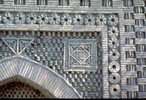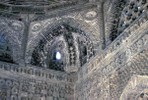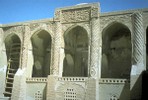Previous Lecture | Next Lecture
Concepts
Characteristics of Islamic Monumentality:
Integration of Monuments in their Urban Context: The result of a predisposition to standardize, generalize, homogenize.
- The Exceptions: Commemorative monuments.
Polyvalence of Forms: No specific form for a specific function.
The Importance of the Interior: The ephemeral nature of matter.
The Predominance of Decoration:
- The amalgamation of forms, colors, surfaces
- The repetition of decorative patterns
- The abstraction of decoration
Architectural Terms
Qubba: Literally "dome", but the word often signified the mausoleum of an amir or a pious man, which was usually, but not always, a cubical structure covered with a dome.
Mashhad: A complex term that means either a memorial for a shahid (witness of the greatness of God, but later exclusively meaning martyr) or a memorial for a true vision, which mostly involves the Prophet or members of his family.
Hazar-baf: a textile term borrowed in Persian brick architecture to designate the woven-like, checker-board quality of brick decoration that appeared in the ninth century.
Chahar taq: a term referring to the form of the pre-Islamic Zoroastrian fire temples of Iran; a domed square with an opening on each side and no doors
Dihqans: the landed nobility of pre-Islamic Iran and Central Asia
Sasanians: dynasty which ruled Iran from 226-651; capital was Ctesiphon.
Sogdians: Central Asian people who inhabited and ruled the land roughly corresponding to the modern country of Uzbekistan up until the Arab invasion in the 8th century.
Ziyarids: dynasty which ruled part of the Caspian provinces of Iran from 932 to c. 1075; nominally Islamic but holding to pre-Islamic Persian traditions and claiming descent from the Sasanians; responsible for several tomb towers, including Gunbad-i Qabus and Pir-i Alamdar.
Samanids: dynasty which ruled part of former Sogdian territory from 819-1005; capital was Bukhara; patrons of New Persian literature, science and architecture.
Monuments
The Samanid Mausoleum in Bukhara, Uzbekistan
(ca. 914), built by Nasr ibn Ismail, square canopy tomb; tapering walls; engaged columns on the corner; very rich decorative program using brick motifs and patterns. Dome support: ribbed, double-arched squinches.
Tarik Khana Mosque, Damghan, Iran
(between 750-89): hypostyle, large axial nave, heavy cylindrical brick piers support elliptical, pointed arches; roof, barrel vaults.
Masjid-i-Jami, Nayin, Iran
Nayin, Iran: (10th century), hypostyle; heavy cylindrical pillars; carved stucco decoration. Minaret is a transition between western minarets and later Iranian ones.
Masjid-i-Ta', Balkh, Afghanistan
(first half of the 9th century). A nine-domed open pavilion with only a qibla wall, heavy brick piers and coupled-columns on the side walls; carved stucco decoration similar to Samarra styles.
Gunbad-i-Qabus in Gurgan, Iran
(1006-7), a ten-sided star plan, a high cylindrical tower (52 m) that ends in a conical dome. Paradoxically identified as a qasr in the inscription.







